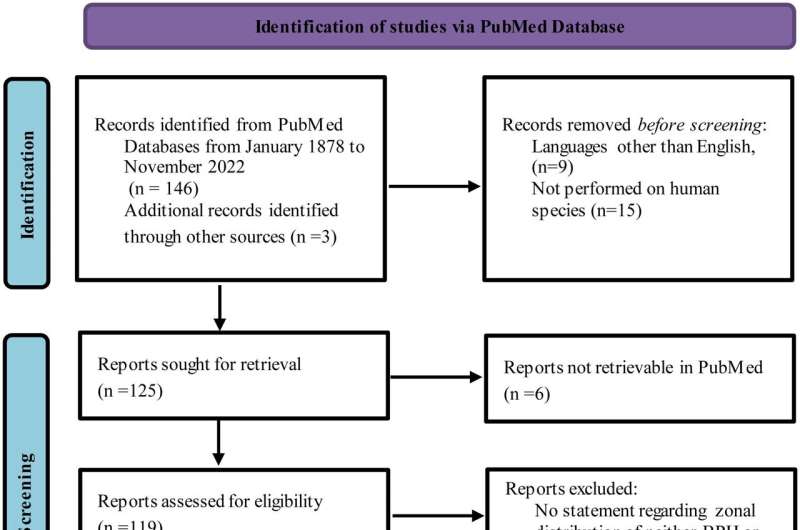This article has been reviewed according to Science X's editorial process and policies. Editors have highlighted the following attributes while ensuring the content's credibility:
fact-checked
proofread
The origin of BPH and prostate cancer in different prostate zones and the impact on the incidence of prostate cancer

Benign prostatic hyperplasia (BPH) and prostate cancer (PCa) are two of the most common prostate conditions among elderly men, with a significant percentage experiencing one or both conditions. Prostate cancer is the most prevalent non-skin cancer and the second leading cause of cancer-related mortality among men in the United States.
Despite the coexistence of BPH and PCa, their interaction and the reasons behind the zonal origin of these diseases remain poorly understood. Recent studies suggest an inverse relationship between prostate size due to BPH and the incidence and aggressiveness of PCa, hypothesizing that a larger prostate size might be protective against PCa. A systematic review, published in the journal Exploratory Research and Hypothesis in Medicine, aims to provide a comprehensive overview of the historical and clinical understanding of the zonal origins of BPH and PCa.
Clinical observations over recent years have reported an inverse relationship between BPH size and the incidence of PCa, leading to the hypothesis that an expanding BPH zone may damage glandular tissue where PCa predominantly develops. The primary objective of this systematic review is to establish a historical basis and reference for the zonal origins of BPH and PCa within the prostate, aiding clinicians in understanding the dynamics between different prostate zones.
Using the PRISMA guidelines, a thorough review of studies published in the PubMed database between January 1978 and November 2022 was conducted. Due to the clinical heterogeneity in study designs, a meta-analysis was not feasible, and a narrative review approach was adopted. Studies included in this review were selected based on their relevance to the zonal origins of BPH and PCa, excluding those that did not meet specific inclusion criteria.
The review included thirty-eight studies that met the inclusion criteria, with findings consistently showing that BPH predominantly develops in the transition zone (TZ) and PCa in the peripheral zone (PZ) of the prostate. The sample sizes of the studies ranged from 4 to 2,494 patients or specimens, with several studies including large multi-institutional cohorts.
For instance, Iremashvili and collaborators found that in 1,411 radical prostatectomy specimens, 80.9% of PCa cases originated from the PZ, while only 10.4% originated from the TZ. None of the studies reviewed showed a larger percentage of PCa originating from the TZ or BPH from the PZ.
The evidence from the reviewed studies overwhelmingly supports the hypothesis of zonal origins for BPH and PCa. For example, Kojima and team reported that 88% of primary PCa tumors originated in the PZ, while only 12% were from the TZ. Additional studies supported these histopathological findings, although some were excluded from the review due to not meeting the inclusion criteria. An interesting study by Mikolajczyk and team found higher levels of pro-prostate-specific antigen in the PZ compared to the TZ, suggesting that this marker might be more specific for PCa in the PZ than BPH in the TZ. Another notable study by Wilson and collaborators further elucidated the zonal dynamics within the prostate.
This systematic review is the first to comprehensively address the zonal origins of BPH and PCa, marking an important step in evidence-based medicine. The findings underscore the importance of understanding the dynamic interactions between different prostate zones, particularly between the TZ and the PZ.
Future research should focus on exploring whether BPH size may indeed have a protective effect against the development of PCa, encouraging clinicians and investigators to further study the intricate relationships within prostate zonal anatomy.
This review provides a detailed historical and clinical context for the zonal origins of BPH and PCa, offering valuable insights for urologists and clinicians in diagnosing and managing these prevalent conditions. The inverse relationship between BPH size and PCa incidence remains a critical area for ongoing research, with significant implications for patient care and treatment strategies.
More information: Jake Sellers et al, The Origin of BPH and Prostate Cancer in Different Prostate Zones and the Impact on the Incidence of Prostate Cancer: A Systematic Review and Update of the Literature for Urologists and Clinicians, Exploratory Research and Hypothesis in Medicine (2023). DOI: 10.14218/ERHM.2022.00120





















